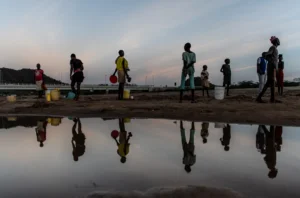
Why in news?
- Climate change is no longer a distant threat. Its devastating impacts are being felt around the world, displacing millions of people from their homes.
- This phenomenon, known as climate migration, is a complex and growing crisis that demands global attention and action.
Who are Climate Refugees?
- Climate migrants are those forced to leave their homes due to sudden or gradual environmental changes caused by climate change.
- These changes can include floods, droughts, rising sea levels, and desertification.
- Unlike refugees fleeing conflict, climate migrants are not currently recognized under international law, leaving them in a precarious situation.
The Causes of Climate Migration
- Sudden-Onset Disasters:
- Extreme weather events like floods, hurricanes, and earthquakes can cause large-scale displacement.
- People flee to safer grounds within their countries, but returning home can be difficult due to destroyed infrastructure and lost livelihoods.
- Slow-Onset Disasters:
- Environmental degradation caused by droughts, desertification, and salinization destroys land and water resources.
- This makes it difficult for people to sustain their livelihoods, pushing them to migrate in search of better opportunities.
- Rising Sea Levels:
- Coastal communities are at particular risk from rising sea levels, which threaten to inundate homes and farmland.
- This can lead to permanent displacement as entire regions become uninhabitable.
The Complexities of Climate Migration
- Climate migration is rarely caused by a single factor.
- Poverty, political instability, and lack of social safety nets often combine with environmental disasters to force migration.
- Additionally, quantifying climate migration is challenging, making it difficult to develop effective policies.
International Efforts and Challenges
- The international community has recognized the issue of climate migration, but progress on solutions has been slow.
- The Geneva Convention, which defines refugees, does not include climate disasters as a reason for seeking asylum.
- While regional agreements have been established, there’s no clear legal framework to protect climate migrants globally.
The Challenges Faced by Climate Migrants
- Climate migrants face a multitude of challenges, including:
- Precarious Livelihoods: Displacement often leads to loss of skills and assets, making it difficult to find new jobs and rebuild livelihoods.
- Integration and Social Challenges: Migrants may struggle to access basic services like healthcare and education, and face difficulties adapting to new cultures and languages.
- Legal Status and Protection: The lack of a legal framework leaves climate migrants vulnerable and without access to refugee protections.
- Psychological and Health Impacts: Displacement can cause trauma and mental health issues. Climate migrants may also be exposed to new health risks in their new locations.
Limitations of Current Policies
- Existing policies like the Global Compact for Migration acknowledge climate change but lack concrete measures to address climate migration.
- Identifying climate refugees and developing collective responses for displaced communities remain significant challenges.
Steps Taken to Address Climate Migration
- Several countries are taking steps to address climate migration:
- Infrastructure Development: Bangladesh is investing in coastal embankments to protect communities from rising sea levels.
- Innovation and Relocation: Island nations like Fiji are exploring raising landmasses and Kiribati is considering planned relocation of populations due to rising sea levels.
- Early Warning Systems: India and Vietnam have implemented early warning systems for extreme weather events to minimize displacement.
- Regional Cooperation: The Kampala Declaration is a regional framework for African countries to address the needs of people displaced by climate change.
- Climate-Smart Agriculture: Ethiopia is investing in drought-resistant crops to help farmers adapt to changing weather patterns and ensure food security.
India’s Climate Change Mitigation Initiatives
- India has several initiatives in place to address climate change and reduce displacement risks, including the National Action Plan on Climate Change (NAPCC), Nationally Determined Contributions (NDC), and National Adaptation Fund on Climate Change (NAFCC).
The Way Forward
- Addressing climate migration requires a multi-pronged approach:
- Tackling Climate Change: Aggressive mitigation strategies to reduce greenhouse gas emissions are crucial to slow climate change and minimize displacement.
- Disaster Preparedness: Disaster preparedness plans, early warning systems, and risk reduction measures can minimize displacement caused by sudden-onset disasters.
- Legal Frameworks: Developing legal frameworks to protect climate migrants, potentially by extending refugee status or creating a new protection category, is essential.
- Planned Relocation: For communities facing permanent displacement due to climate change, planned relocation and resettlement programs may be necessary.
- Sustainable Development: Investing in sustainable development and climate-smart agriculture can create opportunities for people to adapt to climate change and reduce the need for migration.
- Labor Migration Schemes: Encouraging labor migration schemes as an adaptation measure can help displaced populations find new opportunities.
People also ask
Q1: What is climate migration?
Ans: Climate migration refers to the movement of people who are forced to leave their homes due to sudden or gradual environmental changes caused by climate change. This can include floods, droughts, rising sea levels, and desertification.
Q2: Who are climate refugees?
Ans: Climate refugees are a term used to describe people displaced by climate change. However, they are not currently recognized under international law as refugees.
Q3: What is India doing about climate migration?
Ans: India has national plans in place to address climate change and reduce displacement risks, such as the National Action Plan on Climate Change (NAPCC).
Thank you for your sharing. I am worried that I lack creative ideas. It is your article that makes me full of hope. Thank you. But, I have a question, can you help me?
I don’t think the title of your article matches the content lol. Just kidding, mainly because I had some doubts after reading the article. https://accounts.binance.info/sl/register?ref=PORL8W0Z